Abstract:
This essay uses topographic map evidence to interpret landform origins in the Bijou Creek-Beaver Creek drainage divide area in Adams, Arapahoe, Elbert, and Washington Counties, Colorado. Bijou Creek and Beaver Creek are north oriented tributaries to northeastern Colorado’s north-northeast, southeast, east, and northeast oriented South Platte River with Beaver Creek located east of Bijou Creek. A north and northwest oriented tributary to north-northwest oriented East Bijou Creek originates on the floor of the north-to south oriented through valley, which is also drained by headwaters of north-northeast and north Beaver Creek. The through valley is located west Cedar Point and is drained to the south by southeast and south oriented Big Sandy Creek, which flows to the east oriented Arkansas River. North of the Cedar Point through valley, East Bijou Creek and Beaver Creek diverge and north oriented Bijou and Beaver Creek tributaries and north oriented Badger Creek and San Arroyo Creek originate in their drainage divide area. The diverging north oriented drainage routes are interpreted to have originated as converging south oriented flood flow channels prior to headward erosion of the deep southeast, east, and northeast oriented South Platte River valley. Floodwaters were derived from the western margin of a thick North American ice sheet and flowed from western Canada to and across eastern Colorado at a time when ice sheet related crustal warping was raising Colorado and when east oriented valleys were eroding headward into Colorado to capture the immense south oriented melt water flood flow. Headward erosion of the east oriented Arkansas River valley first captured the south oriented flood flow in eastern Colorado and south oriented flood flow channels eroded headward along what is today the Colorado Piedmont. Headward erosion of the deep southeast, east, and northeast oriented South Platte River valley into Colorado from western Nebraska subsequently beheaded the south oriented flood flow channels in sequence from east to west. Floodwaters on north ends of beheaded flood flow channels reversed flow direction to create north oriented South Platte River tributary drainage routes and the north-northeast oriented South Platte River drainage route. Because the flood flow channels were anastomosing and because flood flow channels were beheaded in sequence from east to west floodwaters on newly beheaded and reversed flood flow channels captured south oriented flood flow from flood flow channels further to the west. Such captures of floodwater eroded east oriented valleys and helped create significant north oriented drainage routes. Evidence for the east oriented flood flow is seen in the form of shallow west-to-east oriented through valleys across the present day north-to-south oriented drainage divides and also in the form of southeast and east oriented tributary drainage routes to some of the north oriented South Platte River tributaries.
Preface
The following interpretation of detailed topographic map evidence is one of a series of essays describing similar evidence for all major drainage divides contained within the Missouri River drainage basin and for all major drainage divides with adjacent drainage basins. The research project is interpreting evidence in the context of a previously unexplored deep glacial erosion paradigm, which is fundamentally different from most commonly accepted North American glacial history interpretations. Project essays are listed on the sidebar category list under their appropriate Missouri River tributary drainage basin, Missouri River segment drainage basin (by state), and/or state in which the Missouri River drainage basin is located.
Introduction
The purpose of this essay is to use topographic map interpretation methods to explore the Bijou Creek-Beaver Creek drainage divide area landform origins in Adams, Arapahoe, Elbert, and Washington Counties, Colorado. Map interpretation methods can be used to unravel many geomorphic events leading up to formation of present-day drainage routes and development of other landform features. While each detailed topographic map feature provides detailed evidence to be explained, the solution must be consistent with explanations for adjacent area map evidence as well as solutions to big picture map evidence puzzles. I invite readers to improve upon my solutions and/or to propose alternate solutions that better explain evidence and are also consistent with adjacent map area and big-picture evidence. Readers may do so either by making comments here or by writing and publishing their own essays and then by leaving a link to those essays in a comment here.
This essay is also exploring a new geomorphology paradigm in which erosional landforms are interpreted as evidence left by immense glacial melt water floods. Implied in that interpretation is the immense floods were derived from a thick North American ice sheet that created a deep “hole” in the North American continent and also melted fast. The previously unexplored paradigm being tested in this and other Missouri River drainage basin landform origins research project essays is a thick North American ice sheet, comparable in thickness to the Antarctic ice sheet, occupied the North American region usually recognized to have been glaciated, and through its weight and erosive actions created a deep North American “hole”. The southwestern rim of that deep “hole” is today preserved in the high Rocky Mountains. The ice sheet through its weight and deep erosion (and perhaps deposition along major south-oriented melt water flow routes) caused significant crustal warping and tectonic change, through its action of melting fast produced immense floods that flowed across the continent, and through its action of melting fast systematically opened up space in the ice sheet created “hole” so headward erosion of newly developed north-oriented drainage systems captured immense south-oriented melt water floods and diverted immense melt water floods north into space the ice sheet had once occupied.
If this previously unexplored paradigm is correct the geographic region explored by this essay should contain evidence of immense floods that were captured by headward erosion of new valley systems so as to cause the floods to flow in a different direction. Ability of this previously unexplored paradigm to explain Bijou Creek-Beaver Creek drainage divide area landform evidence in Adams, Arapahoe, Elbert, and Washington Counties, Colorado will be regarded as evidence supporting the “thick ice sheet that melted fast” paradigm.
Bijou Creek-Beaver Creek drainage divide area location map
Figure 1: Bijou Creek-Beaver Creek drainage divide area location map (select and click on maps to enlarge). National Geographic Society map digitally presented using National Geographic Society TOPO software.
Figure 1 provides a location map for the Bijou Creek-Beaver Creek drainage divide area in Adams, Arapahoe, Elbert, and Washington Counties, Colorado and illustrates an area in eastern Colorado. The South Platte River flows in a north-northeast direction from the southwest corner of figure 1 to Denver and then to near Greeley where it turns to flow in a southeast and east direction to Fort Morgan before turning to flow in a northeast direction to the north edge of figure 1 (east of center). North and east of figure 1 the South Platte River flows into western Nebraska to join the North Platte River and to form the Platte River with water eventually reaching the Missouri and Mississippi Rivers. Kiowa Creek, Bijou Creek, and Beaver Creek are north oriented tributaries flowing from the south half of figure 1 to join the east and northeast oriented South Platte River in the north center area of figure 1.Bijou Creek is formed at the confluence of north oriented West Bijou Creek and northeast, north, and north-northwest oriented East Bijou Creek. South of the Kiowa, West Bijou, East Bijou, and Beaver Creek headwaters is east-northeast, north-northeast, and southeast oriented Big Sandy Creek, which flows through the towns of Ramah, Simla, Matheson, Limon, Hugo, and Boyero. South of figure 1 Big Sandy Creek flows in a southeast and south direction to the east oriented Arkansas River, which eventually flows directly to the Mississippi River. East of the Beaver Creek headwaters are headwaters of the northeast oriented Arikaree River, which flows to the east edge of figure 1 (north of center). East of figure 1 the Arikaree River flows into southern Nebraska where it joins the east oriented Republican River with water eventually reaching the Kansas, Missouri, and Mississippi Rivers. The Bijou Creek-Beaver Creek drainage divide area investigated in this essay is located west of Beaver Creek, east of East Bijou Creek, and south of the east oriented South Platte River.
The South Platte River and its tributary drainage routes, like all drainage routes in the Missouri River drainage basin, developed during immense melt water floods from the western margins of a thick North American ice sheet. Floodwaters flowed from western Canada to and across Colorado at the time when deep east oriented valleys were eroding headward into Colorado to capture the massive flood flow and to divert floodwaters to the developing Mississippi-Missouri River drainage system. Headward erosion of the east oriented Arkansas River valley (south of figure 1) first captured the south oriented flood flow in eastern Colorado and the Big Sandy Creek valley eroded headward from the newly eroded Arkansas River valley along and across south and southeast oriented flood flow channels. Headward erosion of the east oriented Kansas River valley and of east oriented Kansas River tributary valleys (e.g. Smoky Hill River and Republican River) in sequence from south to north beheaded south oriented flood flow channels to the newly eroded Arkansas River valley with headward erosion of each Kansas River tributary valley beheading flood flow routes to the newly eroded Kansas River tributary valley immediately to the south (or southeast). Headward erosion of the southeast, east, and northeast oriented South Platte River valley from western Nebraska into northeast Colorado next beheaded south and southeast oriented flood flow channels to actively eroding Republican River tributary valleys (e.g. Arikaree River) and further to the west beheaded south oriented flood flow channels to the newly eroded Big Sandy Creek valley and to the east oriented Arkansas River valley. Floodwaters on north ends of beheaded flood flow channels reversed flow direction to flow to the deeper southeast, east, and northeast oriented South Platte River valley and to create north oriented South Platte River tributary drainage routes and the north-northeast oriented South Platte River drainage route. Because the south oriented flood flow channels diverged and converged and because headward erosion of the deep South Platte River valley beheaded and reversed the flood flow channels in sequence from east to west reversed flood flow in a newly reversed flood flow channel could capture flood flow still moving in a south direction west of the actively eroding South Platte River valley head. Such captures of flood flow helped the reversed flood flow channels create significant north oriented drainage routes, including the present day north-northeast oriented South Platte River drainage route.
Detailed location map for Bijou Creek-Beaver Creek drainage divide area
Figure 2: Detailed location map Bijou Creek-Beaver Creek drainage divide area. United States Geological Survey map digitally presented using National Geographic Society TOPO software.
Figure 2 provides a detailed location map for the Bijou Creek-Beaver Creek drainage divide area in Adams, Arapahoe, Elbert, and Washington Counties, Colorado. County lines are shown and Adams, Arapahoe, Elbert, and Washington Counties are labeled. Lincoln County is the unlabeled county east of Elbert County. The Denver metropolitan area straddles the west edge of figure 2. The South Platte River flows in a north-northeast direction across the northwest corner of figure 2. North of figure 2 the South Platte River turns to flow in a southeast, east, and northeast direction and eventually joins the Nebraska Platte River with water flowing to the Missouri and Mississippi Rivers. Cedar Point is a highway intersection and railroad siding name in eastern Elbert County. Big Sandy Creek flows in an east-northeast and north-northeast direction from the south edge of figure 2 through Ramah, Simla, Matheson, and Resolis toward Cedar Point, but then turns to flow to River Bend and then in a southeast direction to Limon and Hugo and the south edge of figure 2. South of figure 2 Big Sandy Creek flows in a southeast and south direction to join the east oriented Arkansas River, which eventually joins the Mississippi River. Beaver Creek originates a short distance north of Cedar Point and flows in a north-northeast direction across the east margin of Arapahoe County and the northwest corner of Washington County before turning to flow in a north direction to the north edge of figure 2. North of figure 2 Beaver Creek joins the east and northeast oriented South Platte River. East Bijou Creek originates in southern Elbert County and flows in a northeast and east direction before turning to flow in a north direction to near Agate (in northeast corner of Elbert County). From Agate East Bijou Creek flows in a north-northwest direction through Deer Tail in Arapahoe County to join West Bijou Creek in Adams County and to form north-northeast oriented Bijou Creek, which north of figure 2 turns to flow in a north direction to join the east and northeast oriented South Platte River. First Creek is a north-northwest and northwest oriented East Bijou Creek near Deer Tail in Arapahoe County. Muddy Creek is a north-northwest and north oriented stream originating north and east of Agate (just east of the First Creek headwaters) and joins Bijou Creek a short distance north of figure 2. Other East Bijou Creek and Muddy Creek tributaries from the east and shown in figure 2 are not labeled and are oriented in north or north-northwest directions. Beaver Creek tributaries shown in figure 2 from the west are also unlabeled and are oriented in north, north-northeast, and northeast directions. Today the Bijou Creek-Beaver Creek drainage divide area is drained in a north direction and there is no obvious evidence of previous south oriented flood flow. However, the closely spaced north oriented Beaver Creek and Bijou Creek drainage routes and tributary drainage routes originated as diverging and converging south oriented flood flow channels flowing to what at that time was the newly eroded Arkansas River valley and its actively eroding Big Sandy Creek tributary valley. The present day north oriented drainage routes developed when flow directions in those diverging and converging flood flow channels was reversed to create north oriented South Platte River tributary drainage routes.
Bijou Creek-Beaver Creek drainage divide area
Figure 3: Bijou Creek-Beaver Creek drainage divide area. United States Geological Survey map digitally presented using National Geographic Society TOPO software.
Figure 3 provides a reduced size topographic map of Bijou Creek-Beaver Creek drainage divide area. The map contour interval for figure 3 is 10 meters. East Bijou Creek flows in a north, north-northeast, and north direction from the south edge of figure 3 (west half) to the north edge of figure 3 (just west of highway and railroad). North of figure 3 East Bijou Creek flows in a north-northwest direction to join West Bijou Creek and to form north oriented Bijou Creek, which flows to the east and northeast oriented South Platte River with water flowing to the Platte, Missouri, and Mississippi Rivers. Godfrey Gulch originates near the south center edge of figure 3 and drains in a north and north-northwest direction to join East Bijou Creek near Ball Reservoir (just west of Agate-near north center edge of figure 3). East Godfrey Gulch originates east of the Godfrey Gulch headwaters and drains in a north and north-northwest direction to join Godfrey Gulch near the center of figure 3. Cedar Point is a railroad siding name in the southeast quadrant of figure 3 located east of East Godfrey Gulch. South-southeast and south oriented streams originating south and east of Cedar Point are tributaries to southeast and south oriented Big Sandy Creek, which flows to the east oriented Arkansas River, which eventually directly reaches the Mississippi River. Just north of Cedar Point are headwaters of north and northeast oriented Beaver Creek, which flows to the north edge of figure 3 (near northeast corner). North of figure 3 Beaver Creek flows in a north-northeast and north direction to join the east and northeast oriented South Platte River. The east oriented stream draining the escarpment-surrounded upland seen near the east center edge of figure 3 is the Arikaree River, which east of figure 3 flows in a northeast direction to join the east oriented Republican River with water eventually reaching the Kansas, Missouri, and Mississippi Rivers. The west end of the escarpment-surrounded upland is a labeled landform named Cedar Point (not to be confused with the Cedar Point railroad siding). The Cedar Point landform is a triple drainage divide with South Platte River drainage to the north, Arkansas River drainage to the south, and Republican River drainage to the east. Elevations at the landform Cedar Point exceed 1820 meters. Elevations at the Cedar Point railroad siding are between 1740 and 1750 meters. South of figure 3 elevations along the East Bijou Creek-Big Sandy Creek drainage divide exceed 1820 meters suggesting there is a 70-meter deep through valley linking the north oriented East Bijou Creek and Beaver Creek valleys with the southeast and south oriented Big Sandy Creek valley. The through valley was eroded by south oriented floodwaters converging from south oriented flood flow on the present day north oriented Beaver Creek and East Bijou Creek alignments in the Cedar Point railroad siding area and then flowing to the southeast and south oriented Big Sandy Creek valley. Headward erosion of the deep east and southeast oriented South Platte River valley north of figure 3 beheaded and reversed the south oriented flood flow channels to create the north oriented Beaver Creek and East Bijou Creek drainage routes and their north oriented tributary drainage routes.
Detailed map of Beaver Creek-Big Sandy Creek drainage divide area
Figure 4: Detailed map of Beaver Creek-Big Sandy Creek drainage divide area. United States Geological Survey map digitally presented using National Geographic Society TOPO software.
Figure 4 provides a detailed topographic map of the Beaver Creek-Big Sandy Creek drainage divide area seen in less detail in figure 3. The map contour interval for figure 4 is 20 feet. The landform Cedar Point is located near the northeast corner of figure 4 and reaches an elevation of 5991 feet. The Cedar Point railroad siding is located slightly west of the center of figure 4 and has an elevation of 5707 feet. East Godfrey Gulch drains in a north direction near the west edge of figure 4 to the northwest corner of figure 4 and north and west of figure 4 drains in a northwest direction to north and north-northwest oriented Godfrey Gulch, which drains to north and north-northwest oriented East Bijou Creek, which flows to north-northeast and north oriented Bijou Creek, which then flows to the east and northeast oriented South Platte River with water eventually reaching to the Platte, Missouri, and Mississippi Rivers. Beaver Creek originates north of the east end of the Cedar Point railroad siding and flows in a north direction to the north edge of figure 4 (slightly west of center). North of figure 4 Beaver Creek flows in a northeast, north-northeast, and north direction to join the east and northeast oriented South Platte River. North oriented streams flowing to the north edge of figure 4 (east of the highway and railroad) are Beaver Creek tributaries. South-southeast and south oriented streams in the southeast quadrant of figure 4 flow to southeast and south oriented Big Sandy Creek, which joins the east oriented Arkansas River, which eventually flows directly to the Mississippi River. South and west of figure 4 elevations along the East Bijou Creek-Big Sandy Creek drainage divide rise to more than 6000 feet suggesting there is a through valley almost 300 feet deep in the figure 4 region linking the north oriented Beaver Creek and East Godfrey Gulch valleys with the southeast and south oriented Big Sandy Creek valley. Today headwaters of two different north oriented South Platte River tributaries originate on the floor of the through valley and then diverge as they flow along completely independent routes to eventually join the east and northeast oriented South Platte River. Why two independent north oriented South Platte River tributaries would originate in the same location and then flow along completely different routes needs to be explained. The answer is the present day north oriented valleys originated as converging south oriented flood flow channels, which were subsequently beheaded and reversed by headward erosion of the deep east and northeast oriented South Platte River valley. In the context of converging south oriented flood flow channels the figure 4 evidence makes sense.
Muddy Creek-East Bijou Creek drainage divide area
Figure 5: Muddy Creek-East Bijou Creek drainage divide area. United States Geological Survey map digitally presented using National Geographic Society TOPO software.
Figure 5 illustrates a topographic map of the Muddy Creek-East Bijou Creek drainage divide area north and slightly west of figure 3 and includes an overlap area with figure 3. The map contour interval for figure 5 is 10 meters. Agate is a small town on the railroad and highway in the south center area of figure 5. Ball Reservoir is located just west of Agate. East Bijou Creek flows in a north-northeast direction from the south edge of figure 5 (west of center) to just west of Ball Reservoir and then turns to flow in a north-northwest direction to the north edge of figure 5 (west half-next to highway and railroad). North of figure 5 East Bijou Creek flows in a north-northwest direction to join West Bijou Creek and to form north-northeast and north oriented Bijou Creek, which flows to the east and northeast oriented South Platte River. Godfrey Gulch drains in a north and north-northwest direction from the south center edge of figure 5 to join East Bijou Creek near Ball Reservoir. Beaver Creek flows in a northeast direction across the southeast corner of figure 5. East of figure 5 Beaver Creek turns to flow in a north, north-northeast, and north direction to eventually join the east and northeast oriented South Platte River. The north oriented stream originating near the center of figure 5 and flowing to the north center edge of figure 5 is Muddy Creek, which north of figure 5 flows in a north-northwest and north direction to join Bijou Creek. The north oriented stream originating in the southeast quadrant of figure 5 (east of Agate) and flowing to the north edge of figure 5 (near the northeast corner) is Rattlesnake Creek, which north of figure 5 flows in a north-northeast direction to join Beaver Creek. Figure 5 illustrates how the present day north oriented East Bijou Creek and Beaver Creek valleys diverge from each other as they extend in north directions toward the east and northeast oriented South Platte River valley and how north oriented tributary valleys are located between the two diverging valleys. Remember these valleys are diverging from the floor of the same through valley seen in figures 3 and 4. Additional evidence supporting the diverging and converging south oriented flood flow channel hypothesis can be seen along drainage divides south of the north oriented Muddy Creek headwaters valleys. Shallow north-to-south oriented through valleys link the north oriented Muddy Creek headwaters valleys with the north-northwest oriented East Bijou Creek valley. These through valleys are defined by only one or two 10-meter contour lines on a side, which suggests at the time south oriented flood flow moved from the present day north oriented Muddy Creek valley to the present day north oriented East Bijou Creek valley floodwaters were flowing on an erosion surface as high (if not higher) than the elevation of the present day East Bijou Creek-Muddy Creek drainage divide. Flood flow on the Muddy Creek alignment was probably beheaded and reversed prior to the reversal of flood flow in the East Bijou Creek valley, which accounts for the deeper East Bijou Creek valley today. This concept is discussed further in the figure 6 discussion.
Detailed map of Muddy Creek-East Bijou Creek drainage divide area
Figure 6: Detailed map of Muddy Creek-East Bijou Creek drainage divide area. United States Geological Survey map digitally presented using National Geographic Society TOPO software.
Figure 6 provides a detailed topographic map of the Muddy Creek-East Bijou Creek drainage divide area seen in less detail in figure 5. The map contour interval for figure 6 is 20 feet. East Bijou Creek meanders in a north and north-northwest direction from the south edge of figure 6 (near southwest corner) to the west edge of figure 6 (north half). West and north of figure 6 East Bijou Creek flows in a north-northwest direction to join West Bijou Creek and to form north-northeast and north oriented Bijou Creek, which flows to the east and northeast oriented South Platte River. Rattlesnake Creek originates near the southeast corner of figure 6 and flows in a north and north-northeast direction to the east edge of figure 6 (south of northeast corner). East and north of figure 6 Rattlesnake Creek flows in a north-northeast direction to join north-northeast and north oriented Beaver Creek, which flows to the east and northeast oriented South Platte River. The north oriented stream flowing through sections 29 and 20 to the north center edge of figure 6 is Muddy Creek, which north of figure 6 flows in a north-northwest direction to join north-northeast and north oriented Bijou Creek. Rattlesnake Creek originates in a deep north oriented escarpment-surrounded basin, which suggests it was eroded by significant volumes of north oriented flood flow. Where did that north oriented flood flow come from? Headward erosion of the deep east and northeast oriented South Platte River beheaded south oriented flood flow channels in sequence from east to west. In other words, flood flow on the Beaver and Rattlesnake Creek alignment was beheaded and reversed while flood flow continued in a south direction on the East Bijou and Muddy Creek alignments. Reversed flood flow on the Rattlesnake Creek alignment captured south oriented flood flow on the Muddy Creek and East Bijou Creek alignments (remember at that time the deep East Bijou Creek valley had not yet been eroded). The captured flood flow moved in east directions to the actively eroding north oriented Rattlesnake Creek valley (and to east oriented Beaver Creek tributary valleys east of the southeast corner of figure 6). Evidence for this east oriented flood flow is seen in the form of shallow west to east oriented through valleys crossing the rim of the Rattlesnake Creek headwaters escarpment-surrounded basin. A through valley in the northwest corner of section 3 is defined by three contour lines on the north and five contour lines on the south. Prior to headward erosion of that east oriented valley floodwaters probably flowed across the smooth surface in the southeast corner of figure 6 and then in a north direction into the actively eroding north oriented Rattlesnake Creek valley. Headward erosion of a deeper south oriented flood flow channel on the present day north oriented East Bijou Creek alignment probably ended east oriented flood flow to the actively eroding Rattlesnake Creek valley. Subsequently flood flow in the East Bijou Creek valley was beheaded and reversed to create the present day north and north-northwest oriented East Bijou Creek drainage route.
Muddy Creek-Beaver Creek drainage divide area
Figure 7: Muddy Creek-Beaver Creek drainage divide area. United States Geological Survey map digitally presented using National Geographic Society TOPO software.
Figure 7 illustrates a reduced size topographic map of the Muddy Creek-Beaver Creek drainage divide area north of figure 5 and there is an overlap area with figure 5. The map contour interval for figure 7 is 10 meters. East Bijou Creek flows in a north-northwest direction across the southwest corner of figure 7. West of figure 7 East Bijou Creek joins West Bijou Creek to form north-northeast and north oriented Bijou Creek, which flows to the east and northeast oriented South Platte River. Beaver Creek flows in a north-northeast, north, and north-northeast direction from the south edge of figure 7 (east half) to the east edge of figure 7 (north half). East of figure 7 Beaver Creek flows in a north-northeast and north direction to join the east and northeast oriented South Platte River. Rattlesnake Creek flows in a north-northeast direction from the south edge of figure 7 (east of center) to join Beaver Creek near the east center edge of figure 7. The Cottonwood Valley is located in the east center area of figure 7 and Cottonwood Creek flows in a north-northeast direction in the Cottonwood Valley before turning in an east direction to join Beaver Creek. Badger Creek originates near the center of figure 7 and flows in a north and north-northeast direction to the north edge of figure 7 (east of center). North of figure 7 Badger Creek flows in a north-northeast, north-northwest, and north direction to the east and northeast oriented South Platte River. Muddy Creek flows in a north and north-northwest direction from the south edge of figure 7 (west of center) to Noonen Reservoir and then to the north edge of figure 7 (west half). North of figure 7 Muddy Creek flows in a north direction to join north-northeast and north oriented Bijou Creek. Note how Beaver Creek and East Bijou Creek are diverging from each other even though they both originated on the floor of the same north-to-south oriented through valley seen in figures 3 and 4. Further note how additional north oriented streams are being added between these two diverging drainage routes as we progress in a north direction. This situation is easiest to explain if East Bijou Creek, Beaver Creek, and the other north oriented streams originated as diverging and converging south oriented drainage channels and were subsequently beheaded and reversed to create north oriented drainage routes. Assuming the south oriented flood flow channels were beheaded and reversed by headward erosion of the east and northeast oriented South Platte River valley (north of figure 7) there should be evidence each north oriented valley captured floodwaters from yet to be beheaded flood flow channels further to the west. Figure 8 provides a detailed topographic map of the Muddy Creek-Badger Creek drainage divide area to determine whether such evidence exists.
Detailed map of Muddy Creek-Badger Creek drainage divide area
Figure 8: Detailed map of Muddy Creek-Badger Creek drainage divide area. United States Geological Survey map digitally presented using National Geographic Society TOPO software.
Figure 8 provides a detailed topographic map of the Muddy Creek-Badger Creek drainage divide seen in less detail figure 7. The map contour interval for figure 8 is 20 feet. Muddy Creek flows in a north-northwest direction from the south edge of figure 8 (west half) to the northwest corner of figure 8. North and west of figure 8 Muddy Creek joins north-northeast and north oriented Bijou Creek, which flows to the east and northeast oriented South Platte River. Badger Creek originates in the center area of figure 8 and flows in a north-northeast and north direction to the north edge of figure 8 (east half). North of figure 8 Badger Creek flows in a north-northeast, north, and north-northeast direction to join the east and northeast oriented South Platte River. Cottonwood Creek flows in a north-northeast direction from the south edge of figure 8 (east of center) to the northeast corner of figure 8. East and north of figure 8 Cottonwood Creek flows in an east direction to join north-northeast oriented Beaver Creek, which flows to the east and northeast oriented South Platte River. Each of the three north oriented streams seen in figure 8 uses a different route to reach the east and northeast oriented South Platte River. Is there evidence these present day north oriented drainage routes originated as converging south oriented flood flow channels that were beheaded and reversed in sequence from east to west by headward erosion of the east and northeast oriented South Platte River valley (north of figure 8)? In the northeast quadrant of section 16 a north oriented Badger Creek headwaters valley is linked by a through valley with an east-southeast oriented Cottonwood Creek tributary valley. The through valley is defined by three 20-foot contour lines on the northeast side and by four contour lines on the southwest side and was probably eroded by south oriented flood flow moving from the present day north oriented Badger Creek alignment to reversed flood flow on the Cottonwood Creek-Beaver Creek alignment. Near the south edge of section 16 a higher elevation through valley defined by two contour lines on a side links a west oriented Muddy Creek tributary valley with an east oriented Cottonwood Creek tributary valley. A shallower through valley in the south half of section 5 links a west oriented Muddy Creek tributary valley with an east oriented Badger Creek headwaters valley. These and other similar through valleys provide evidence of multiple flood flow routes across the Muddy Creek-Cottonwood Creek, Muddy Creek-Badger Creek, and Badger Creek-Cottonwood Creek drainage divides. Floodwaters were flowing in south-southeast directions on the yet to be beheaded and reversed Muddy and Badger Creek alignments (before the deep Muddy Creek valley had been eroded) and then in east directions to reach newly reversed flood flow channels on the Cottonwood Creek alignment and helped erode the north oriented Cottonwood Creek valley. Later when headward erosion of the South Platte River valley beheaded and reversed flood flow on the Badger Creek alignment yet to be beheaded and reversed floodwaters flowing on the Muddy Creek alignment flowed in east directions to the newly reversed Badger Creek drainage route and helped erode the north oriented Badger Creek valley. Subsequently south oriented flood flow on the Muddy Creek alignment was beheaded and reversed and captured yet to be beheaded south oriented flood flow from flood flow channels still further to the west.
San Arroyo Creek-Beaver Creek drainage divide area
Figure 9: San Arroyo Creek-Beaver Creek drainage divide area. United States Geological Survey map digitally presented using National Geographic Society TOPO software.
Figure 9 illustrates a reduced size topographic map of the San Arroyo Creek-Beaver Creek drainage divide area north and east of figure 7 and there is an overlap area with figure 7. The map contour interval for figure 9 is 10 meters. Muddy Creek flows in a north-northwest direction across the southwest corner of figure 9 and west and north of figure 9 joins north-northeast and north oriented Bijou Creek, which flows to the east and northeast oriented South Platte River. Little Muddy Creek originates east of Muddy Creek in the southwest corner region of figure 9 and flows in a north-northwest and north direction to the north edge of figure 9 (near northwest corner) and north of figure 9 joins Muddy Creek. Badger Creek flows in a north-northeast, northeast, and north-northeast direction from the south edge of figure 9 (west of center) to the north edge of figure 9 (east half). North of figure 9 Badger Creek flows to the east and northeast oriented South Platte River. Beaver Creek flows in a north-northeast direction from the south edge of figure 9 (east half) to the east edge of figure 9 (north of center). East and north of figure 9 Beaver Creek flows in a north direction to join the east and northeast oriented South Platte River. Wetzel Creek is a north-northeast, north and east-northeast oriented stream originating near the south edge of the southeast quadrant of figure 9 (west of Beaver Creek) and flowing to the east edge of figure 9 (north of Beaver Creek). East of figure 9 Wetzel Creek joins Beaver Creek. San Arroyo Creek originates in northwest quadrant of figure 9 and flows in a northeast and north-northeast direction to the north center edge of figure 9. North of figure 9 San Arroyo Creek disappears as a surface stream as it enters the South Platte River valley, although it is headed toward the point where Bijou Creek joins the South Platte River. Poison Springs Creek originates south of the Sand Arroyo Creek headwaters and flows in a north-northeast, east, northeast, east, and northeast direction to join Badger Creek near the center of figure 9. Southeast oriented tributaries flow to north oriented San Arroyo and Badger Creeks as barbed tributaries and provide evidence of earlier south oriented flood flow, which was captured by reversals of flood flow on the north oriented San Arroyo Creek and Badger Creek alignments and/or by headward erosion of the San Arroyo Creek and Badger Creek valleys. A deep through valley near the Adams-Arapahoe County line in the southwest quadrant of figure 9 links an east oriented Badger Creek tributary valley with a west oriented Muddy Creek tributary valley. The through valley is defined by at least three 10-meter contour lines on each side suggesting it is approximately 30 meters deep. The through valley was probably eroded by east oriented flood flow moving from the yet to be beheaded south oriented flood flow channel on the present day north oriented Muddy Creek alignment to what at that time was a newly reversed flood flow channel on the Badger Creek alignment.
Detailed map of San Arroyo Creek-Poison Springs Creek drainage divide area
Figure 10: Detailed map of San Arroyo Creek-Poison Springs Creek drainage divide area. United States Geological Survey map digitally presented using National Geographic Society TOPO software.
Figure 10 provides a detailed topographic map of the San Arroyo Creek-Poison Springs Creek drainage divide area seen in less detail in figure 9. The map contour interval for figure 10 is 20 feet. Badger Creek flows in a north and north-northeast direction from the south edge of figure 10 to the northeast corner of figure 10. North and east of figure 10 Badger Creek flows in a north-northeast and north direction to join the east and northeast oriented South Platte River. Poison Springs Creek flows in a northeast, east-southeast, northeast, east, and northeast direction from near the southwest corner of figure 10 to join Badger Creek in the northeast quadrant of section 1. San Arroyo Creek flows from the west edge of figure 10 (south of center) into the northwest corner of section 8 and then turns to flow in a north and northeast direction to the north edge of figure 10 (west half). North of figure 10 San Arroyo Creek flows in a northeast and north direction to disappear as a surface stream near the South Platte River valley (near the point where Bijou Creek enters the South Platte River). Evidence for south oriented flood flow across the region is seen in the form of the southeast oriented and barbed tributaries flowing to north oriented San Arroyo Creek and to north oriented Badger Creek. Headward erosion of the deep north-northeast oriented Badger Creek valley and its east oriented Poison Springs Creek tributary valley captured multiple southeast oriented flood flow routes. North-northwest and north oriented Badger Creek tributary drainage routes were created by reversals of flood flow on north-northwest and north ends of beheaded flood flow routes. Further evidence for flood flow is seen in the form of through valleys linking the north oriented San Arroyo Creek valley with southeast oriented Poison Springs Creek and Badger Creek tributary valleys. For example in section 8 a through valley links the north oriented San Arroyo Creek valley with southeast oriented Poison Springs Creek tributary valleys and is defined by at least four 10-foot contour lines on each side. This through valley was eroded by south oriented flood flow from the yet to be beheaded and reversed San Arroyo Creek alignment, which was moving to what at that time was the newly beheaded and reversed Badger Creek valley. Subsequently flood flow on the San Arroyo Creek alignment was beheaded and reversed to create the north oriented San Arroyo Creek drainage route.
Additional information and sources of maps studied
This essay has provided only a sample of the detailed topographic map evidence supporting the flood erosion interpretation. Many additional illustrations could be provided. Readers are encouraged to look at mosaics of detailed topographic maps to see the abundance of available data. Maps used in this study were created and published by the United States Geologic Survey and can be obtained directly from the United States Geological Survey and/or from dealers offering United States Geological Survey maps. Hard copy maps can also be observed at United States Geological Survey map depositories, which are located throughout the United States and elsewhere. Illustrations used here were created using National Geographic Society TOPO software and digital map data. TOPO software and map data can be obtained from the National Geographic Society and/or dealers offering National Geographic Society digital map data.

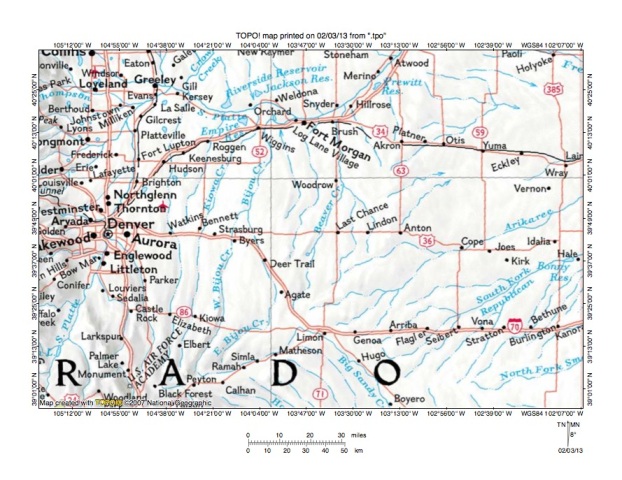
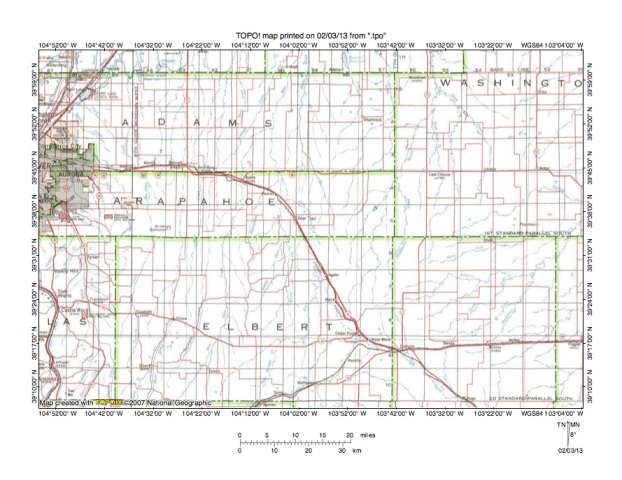

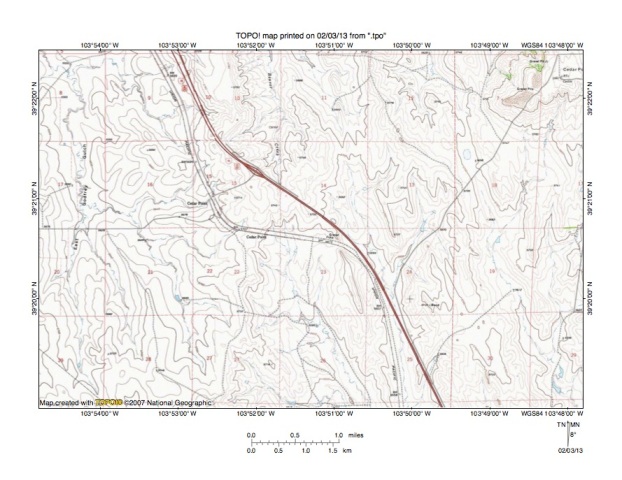
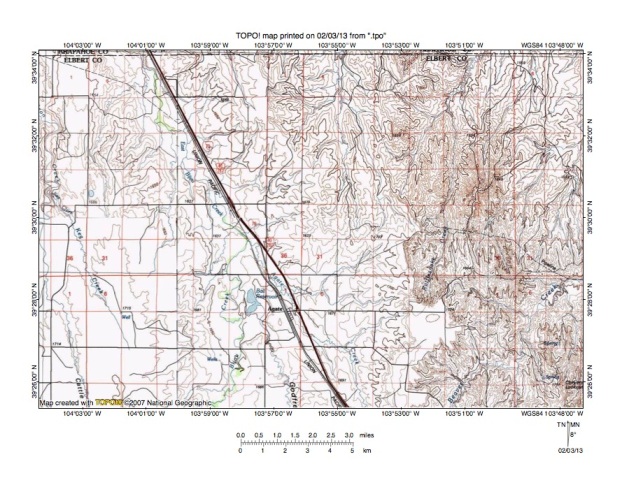
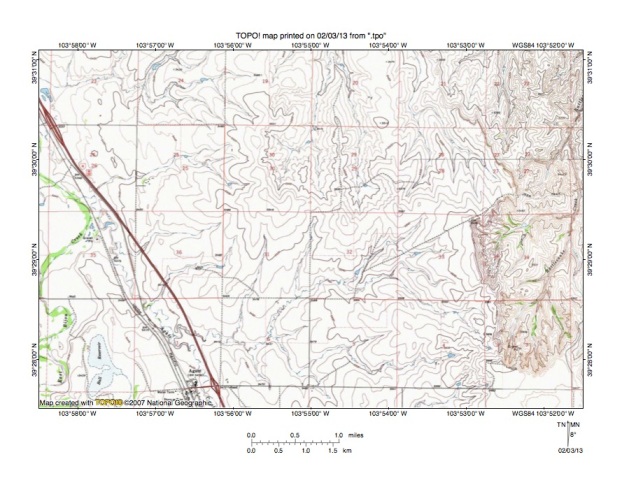
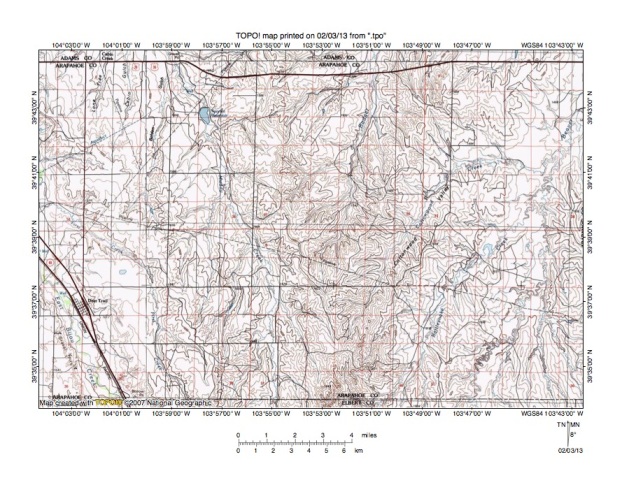
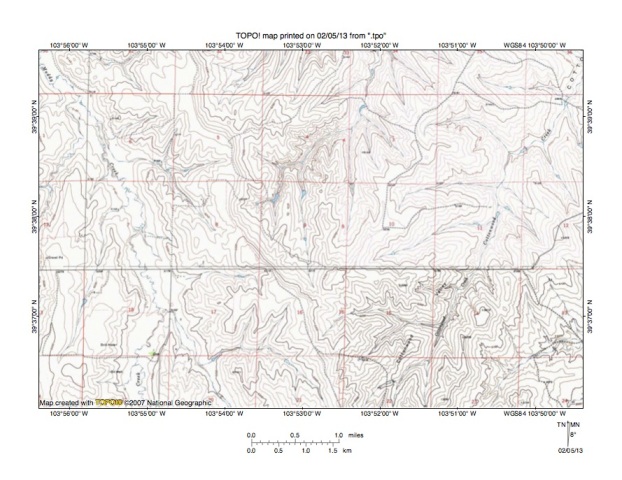


Leave a comment